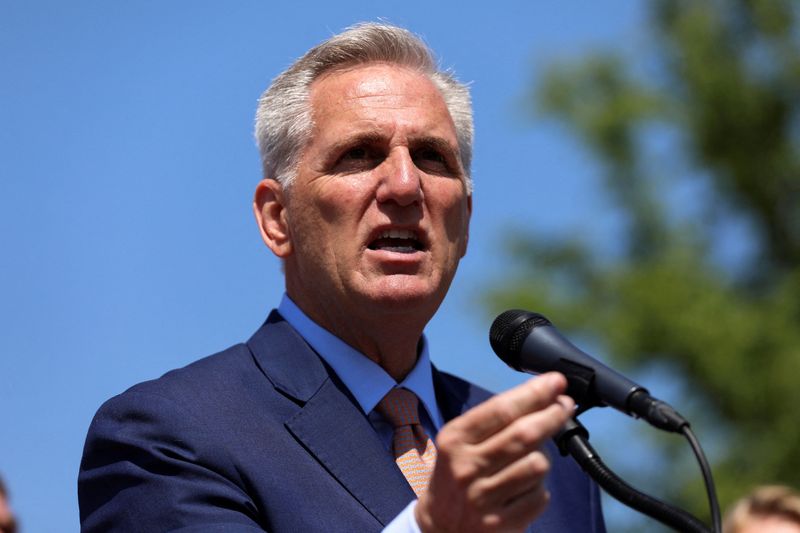WASHINGTON (Reuters) – U.S. House of Representatives Speaker Kevin McCarthy has floated a plan that would pair $4.5 trillion in spending cuts with a $1.5 trillion increase in the U.S. debt ceiling.
His proposal does not include some of the more dramatic fiscal ideas floated by Republicans who control the House. Here are some possibilities that did not make the cut:
WILL IT BALANCE THE BUDGET?
Total U.S. debt has risen steadily over the past two decades as the government has not collected enough revenue to cover its costs. The $31.4 trillion national debt is now equal to 98% percent of the economy, up from 32% the last time the United States posted a budget surplus in 2001.
Some House Republicans have called for balancing the budget within 10 years, but McCarthy’s proposed cuts would almost certainly not hit that goal. His promised $4.5 trillion in savings would fall well short of the $16.7 trillion in spending cuts that the Republican Study Committee, a group of House conservatives, outlined in its balanced budget proposal last year.
Republicans would get another chance to extract more cuts, as his proposed debt-ceiling hike would not cover the nation’s borrowing needs past March 31, 2024.
DOES IT CUT TAXES?
Republicans have broadly ruled out tax increases as way to tame the national debt. McCarthy’s plan would revoke a budget increase for the Internal Revenue Service that the nonpartisan Congressional Budget Office predicts would boost revenue by $204 billion over the coming 10 years due to increased enforcement.
McCarthy’s plan would not repeal two tax hikes secured by Democrats in last year’s Inflation Reduction Act: a 15% minimum tax on large corporations and a 1% excise tax on stock buybacks. The CBO predicted those would raise $222 billion over 10 years.
It also does not try to make permanent the temporary individual tax cuts contained in the 2017 Republican tax-cut package that are due to expire in 2025.
DOES IT DEFUND THE FBI?
Former President Donald Trump called for defunding the Justice Department and the FBI following his criminal indictment in New York earlier this month. His former budget director, Russell Vought, called for cuts to housing, education and health programs in a proposal released earlier this year.
McCarthy’s plan steers clear of these sorts of specifics. Instead, it would cut a broad swath of “discretionary” spending by 9% in the next fiscal year and limit increases to 1% annually after that. Lawmakers would have to work within those constraints to set funding levels for agencies like the Pentagon and the Environmental Protection Agency.
WHAT ABOUT SOCIAL SECURITY AND MEDICARE?
The Social Security retirement program and the Medicare health plan for seniors together are projected to double in cost over the next 10 years as the population ages. Recipients could face sharp benefit cuts if Congress does not shore up the trust funds that help cover costs.
McCarthy’s plan would not touch either program, and he has said they are off limits. This makes political sense, as Republican and Democratic voters alike say they do not support benefit cuts.
That is a contrast with previous Republican House speakers like John Boehner, who proposed raising the retirement age, and Paul Ryan, who called for partially privatizing Medicare — as well as former President George W. Bush, who unsuccessfully tried to partially privatize Social Security during his tenure.
More recently, the Republican Study Committee proposed raising the age at which Americans would become eligible for both programs.
WILL IT REPEAL OBAMACARE?
Opposition to Democratic former President Barack Obama’s Affordable Care Act was a unifying goal for Republicans over the past decade. But they came up short in a 2018 attempt to repeal the sweeping expansion of health coverage.
Since then, seven Republican-led states have opted to expand Medicaid coverage for low-income Americans, a key pillar of the law.
Some 16 million Americans signed up for subsidized insurance through Obamacare’s exchanges this year, the highest level yet. Another 21 million receive coverage through the Medicaid expansion.
McCarthy’s plan would not repeal Obamacare, or roll back enhancements secured by Democrats in 2021 and 2022.
(Reporting by Andy Sullivan; Editing by Scott Malone and Jonathan Oatis)
